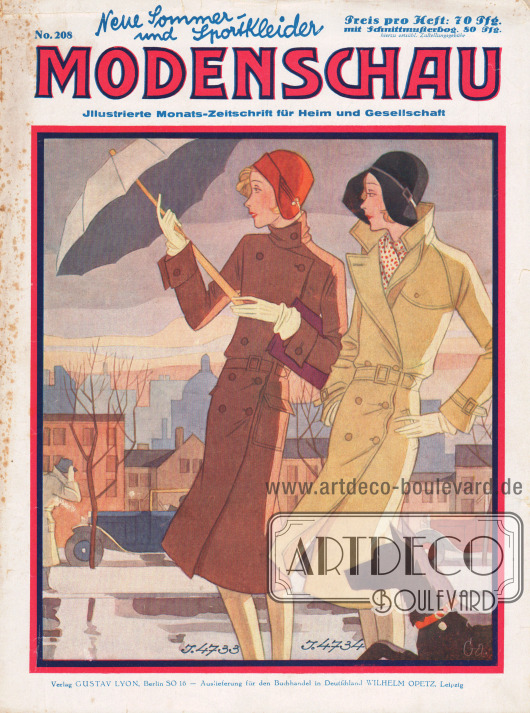|
|
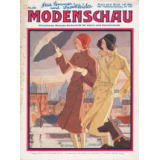
|
Front page, title page or cover of the German fashion magazine Modenschau (Eng. title: Fashion Show, subtitle: Illustrated Monthly Magazine for Home and Society) no. 208 for April 1930.
New summer and sportswear.
J 4733. Raincoat made of waterproof wool fabric with widely buttoned front parts. Large pockets. Sleeves with broad cuffs. Fabric usage: about 3 m, 130 cm wide. Pattern size 44 and 48. Price 1 mark.
J 4734. Trench coat with buttoned, checked lining. Double-breasted button closure, slanted pockets. Fabric usage: about 3.25 m, 130 cm wide. Pattern size 44 and 48. Price 1 mark.
Price per issue: 70 pfennigs, with pattern sheet 80 pfennigs plus local delivery charge.
Publishing house GUSTAV LYON, Berlin SO 16 — Distribution for the book trade in Germany WILHELM OPETZ, Leipzig.
Title illustration/title drawing: "Ga.", Gerhard Georg August Gagelmann or Gert Gagelmann (1902-1964)
|
|
|
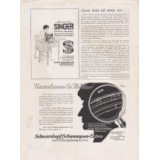
|
Article:
N. N., I Have Plans for Today…
[N. N., I Have Plans for Today…]
"Today I have plans, today I have to make myself beautiful!" So you hear them say, the women who only remember their beauty in exceptional cases. The poorest! They wash themselves, they powder themselves, they put on perfume, and yet they meet women who look better than they do: unaffectedly groomed, naturally beautiful, truly attractive. The reason? Here it is:
Women who have a healthy sense of personal hygiene; women who possess natural vanity; women who appear so incredibly appetizing have the need to always be uniformly beautiful, regardless of whether they are alone, whether they are working, whether they are doing sport, whether they are representing. They are not familiar with this ominous: "I can't be seen now — —". They do their daily facial care routine either out of natural instinct or out of good consideration.
Let's consider together what you can do for the beauty of your face through habitual care.
Your facial skin is exposed to the weather and dust from the street. You wash your face as a matter of course. But washing your face is not enough because it only cleanses it superficially, not thoroughly. Trying a subsequent treatment with toner will prove this to you. You will certainly be horrified when you see how much dirt the cotton pad soaked in toner brings to light at the moment when you think you have just washed, i.e. are completely clean. Facial toner penetrates deep into the pores and prevents the dust and dirt particles that appear so unpleasant and ugly in their altered form as blackheads or pimples from settling. Treatment with facial toner also fulfills another purpose. Toner stimulates blood circulation in the pores, which is the most natural preventive measure against wrinkles, sagging skin and a dull complexion.
Now it is important to use the beauty of the skin gained in this simple way to perfect the beauty of your face. … (See third cover page for conclusion).
Advertising:
With my SINGER and its equipment, I can make the most delightful festive dresses myself. (SINGER NAEHMASCHINEN [SEWING MACHINES] SINGER) The most extensive payment facilities. Moderate monthly installments — SINGER NAEHMASCHINEN AKTIENGESELLSCHAFT [STOCK CORPORATION]. Singer stores everywhere. Drawing/illustration: unknown/unsigned.
Neutralize your hair!
According to the latest scientific research, the alkalis contained in every shampoo, which are necessary to dissolve dirt and grease, cannot be completely removed by rinsing with water alone.
Schwarzkopf Haarglanz-Pulver [Hair Shine Powder] is the ideal solution: it "neutralizes" the hair, restoring its strength and giving it an extra shine.
So if you want to keep your hair healthy and beautiful in the long term, use Schwarzkopf Hair Shine Powder after every hair wash.
Each bag of Schwarzkopf-Extra comes with Hair Shine Powder free of charge.
a. Hair that has swollen during the cleansing process.
b. Hair that has been "neutralized" by Hair Shine Powder and restored to its natural strength.
Schwarzkopf-Extra makes your hair beautiful, Schwarzkopf-Haarglanzpulver [Hair Shine Powder] keeps it healthy!
Schwarzkopf-Schaumpon-Extra [Shampoo] with Hair Shine Powder. Drawing/illustration: "(BA) heinz" or rather "(BA) heins" (unknown artist's signature).
|
|
P. 1 |
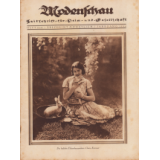
|
Title page or cover of the Modenschau (Eng. title: Fashion Show, subtitle: Magazine for Home and Society) no. 208 for April 1930.
ISSUE 208 / APPEARING MONTHLY / YEAR 1930.
The large-format cover photo shows a young smiling woman in the foreground in a long dress with short sleeves, sitting in the grass under a tree with long branches reaching down. She is gently holding a bunny to her chest with both hands. Next to her is a large woven basket in which another rabbit is sitting. The scene is illuminated by the sun from above. The caption reads "The popular film actress Claire Rommer [1904-1996]".
Photo: Studio Ernst Schneider, Berlin (1881-1959).
[Page] 1
|
|
P. 2 |

|
Article:
Muenzer, Kurt, Monna Renata (by Kurt Muenzer, 1879-1944).
The story is illustrated by two drawn pictures. The left-hand picture shows a young woman in a long robe in a room with a curtain and crown glass window (bullseye glass or plate glass window). The right-hand picture shows a young man in a short cloak and tight trousers with a dagger at his belt. Both images show a couple in the 15th century. Drawing/illustration: "k" (Ernst Ludwig Kretschmann, 1897-1941).
[Page] 2
|
|
P. 3 |
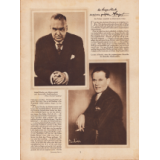
|
Article:
Fischer, Alfred Joachim, The Moment of My Greatest Fear. A Survey Organized by Alfred Joachim Fischer (journalist and author, 1909-1992).
Two pictures of the interviewed protagonists are printed to accompany the article. The captions read "Rudolf Presber [1868-1935], a master of serious and humorous storytelling (Photo: Otto Kurt Vogelsang)" and "Luciano Albertini [Italian film star, 1882-1945], one of the most daring actors in German adventure film".
Photos: Otto Kurt Vogelsang (biographical data unknown); photo studio Alexander Balázs, Berlin (1890-1932).
[Fischer, Alfred Joachim, The Moment of My Greatest Fear.]
The time of absolute heroism is finally over. We no longer believe that there are heroes without fear and reproach, we rather believe in a little fear and horror even in the most daring man's heart.
But after all, everyone has a little fear of ridicule and for this reason does not like to confess when the bad feeling of fear has been expressed too much. "Back then, when I mastered such and such an important role - - - back then, when I interviewed such and such a king, minister or field marshal on the battlefield at the risk of my life" - - - that's what they like to say. But to divulge something of their weaknesses, which are all too human, no and no again. The good impression could easily be destroyed and the finely woven nimbus torn apart. Our task today is to break with this long-established method. And it certainly takes great courage to take part in the survey "The moment of my greatest fear".
Dr. Rudolf Presber, a master of serious and humorous storytelling, talks about a critical episode in his life as follows: "As a serious sport, swimming was always my favorite. And since I - - I don't know by what disposition - - could hold my breath for a particularly long time or switch it off, I liked to dive. I practiced this once - - I think as a fifteen-year-old - - in Gerlach's bathing establishment in my hometown of Frankfurt; jumped into the Main and dived and swam a good distance under the water. But I must have strayed from the straight line. Because suddenly, when I, desperate for air, wanted to get back to the surface and kicked the water hard with my feet, my head hit the boards that were lying close to the water. I was under the boardwalk … At that moment, when I had hardly any air left and didn't know whether I had gone under the wooden footbridge to the left or right, i.e. whether I could find my way back into the pool and into the air to the right or left, I went through a mortal fear that I will never forget. … (Continued on page 37).
[Page] 3
|
|
P. 4 |
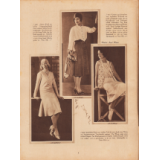
|
J 4860. Smart dress in light-colored diagonal wool fabric. Several link buttons on the front incision as closure. Horizontal piping adorns the long bodice, to which the skirt is attached. Slim sleeves. Fabric usage: about 2.30 m, 130 cm wide. Pattern size 44. Price mark 1.—.
J 4861. Suit made of finely mottled English wool fabric with a slightly fitted jacket with a lapel collar and one-button closure. Button trim on the skirt. Blouse made of wash silk, complemented by colored material. Fabric usage for the costume: about 3.10 m, 130 cm wide, for the blouse: 1.55 m, 0.55 m facing fabric each 100 cm wide. Pattern size 44. Price mark 1.—.
J 4862. Sporty dress made of white wash silk, complemented by a vest made of colorful patterned travisé silk [artificial silk or rayon]. The vest has a white collar. Dress worn with patterned belt. Fabric usage: about 3 m white, 1.50 m patterned, each 80 cm wide. Pattern size 44. Price mark 1.—.
Photos: photo studio Joel Feder, New York City (biographical data unknown).
[Page] 4
|
|
P. 5 |
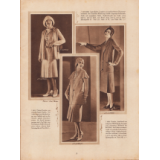
|
J 4863/4864. Youthful ensemble made of fashion-colored fantasy wool fabric. The sleeveless dress has pleats at the sides. Jacket with attached scarf. Fabric usage for jacket: about 2.20 m, 130 cm wide, for dress: about 1.80 m, 130 cm wide. Price for jacket: 75 pfennigs, for dress: mark 1.—.
J 4865. Smart street suit made of medium-colored kasha. The jacket has a shoulder cape. At the sides and on the sleeves, there are fancy trimmings which are pulled through clasps. Pleats at the front of the skirt. Fabric usage: about 3.60 m, 130 cm wide. Pattern size 44. Price mark 1.—.
J 4866. Tailor-made suit consisting of mottled wool fabric for the jacket and striped wool fabric for the skirt with pleats. Jacket with side division. Single-breasted closure. Fabric usage: about 2 m mottled, 130 cm wide, 1.40 m striped, 120 cm wide. Pattern size 44. Price mark 1.—.
Photos: photo studio Joel Feder, New York City (biographical data unknown).
[Page] 5
|
|
P. 6 |
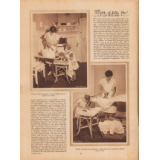
|
Article:
Sell, Anita, Mommy, I'll Help You! (by Anita Sell, unknown author).
The photographs attached to the article show mother and daughter in the kitchen washing and drying dishes and ironing laundry. The captions read "What mother washes up, diligent children's hands dry with care" and "Mother's traveling iron is just the right size for little hands (Photos: Frank)".
Photos: Frank (unknown photographer).
[Sell, Anita, Mommy, I'll Help You!]
A silver child's voice calls out these words to her mother, who is in the midst of domestic chores. Joyful helpfulness, childlike tenderness and – a tiny bit of anxious embarrassment sound through this question. Embarrassment? Well, isn't it a great risk to disturb mother's seriousness about work, will she realize that little one is really serious about this offer? When you are still so small, the "grown-ups" laugh so easily and don't understand at all that you would like so much to handle these strange things, to get to know all those interesting things that the grown-ups always talk about when they talk about "work". How is it possible that the grown-ups are not at all amused, indeed often quite annoyed and displeased about the "drudgery"? If baby had already become acquainted with modern psychology, then the solution to the riddle would have been found immediately: what you have to do is a compulsion and therefore not appreciated – but if you are allowed to do the same thing at your own whim, at your own choice and at your own pleasure, then it is a pleasurable affair. Or, if we want to put it very briefly and scientifically: the attitude to the activity determines the feeling of pleasure and displeasure! Fortunately, little one does not need to torment himself with such definitions and considerations – what is his mother's duty seems to him to be a highly desirable occupation and therefore he offers to cooperate. This question, however, must of course be answered somehow by the mother, for nothing is more uneducational and hopeless than to ignore children's questions. Little people have an uncanny tenacity to keep asking until they get an answer! It could be that the mother, perhaps nervous and rushed by the abundance of housewifely duties, helps herself with the most convenient excuse of all adults towards the child: "You're still far too small for that!" – but that shouldn't be the case. For the child means it quite honestly, it wants to help, wants to show that it is already big enough to help. Rejection of his offer thus affects his self-confidence and can later lead to the development of the trait of character that modern psychology calls the "inferiority complex", i.e. the feeling of not being able to do something, the lack of confidence in one's own strength! So this question cannot be answered in any way, but only in the affirmative: "That's so sweet of you to want to help me!" Now the child feels proud that it is allowed to be on an equal footing, so to speak, and happy because it sees its wish to participate in the "big ones'" activities fulfilled. … (Continued on page 16).
[Page] 6
|
|
P. 7 |
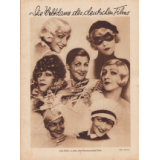
|
The world's leading lady of German film.
Large-format photo-montage with seven shots. The caption reads "Ellen Richter [1891-1969] in seven sharply contrasting roles (Photo: Star-Film)".
Photos: Star-Film.
[Page] 7
|
|
P. 8 |
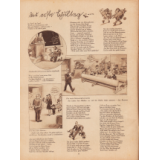
|
Article (rhymes):
Malkowsky, Emil Ferdinand, The First Day of School (by Emil Ferdinand Malkowsky, 1880-1967).
Drawings/illustrations: Hans Ewald Kossatz (1901-1985).
[Page] 8
|



